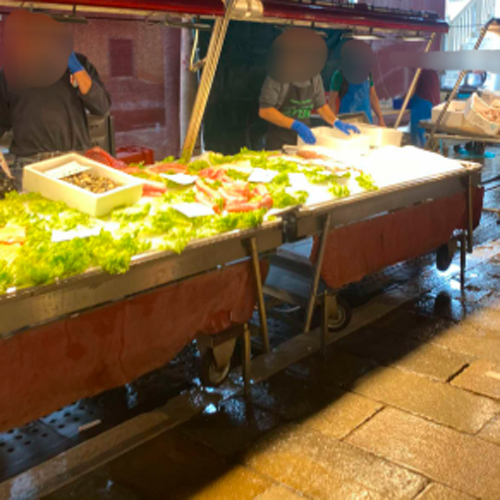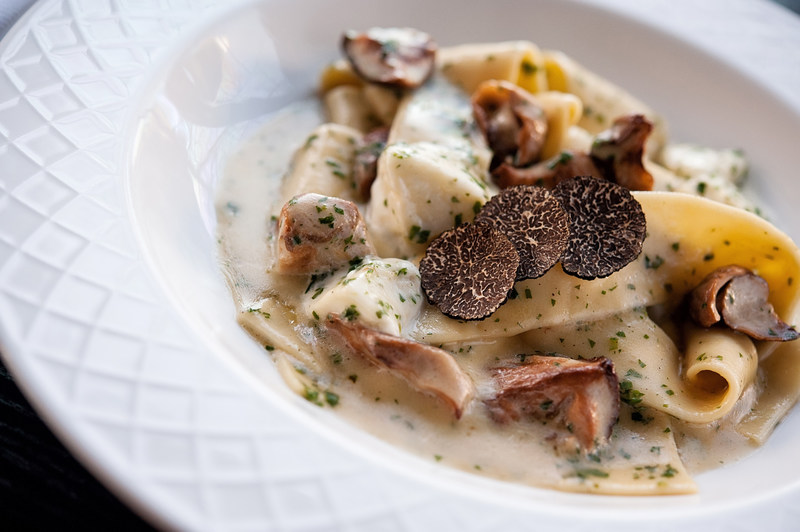The Code of the Respectful Tourist
Being a polite tourist is a very simple challenge; you just need to follow basic rules of personal etiquette. But what if you don’t know how to say, for example, “Please,” “Thank you,” or “Sorry”? Thanks to this text, you will learn some basic polite phrases that you can use in conversations with Italians. At the very beginning of the day, when you want to greet someone, it’s good to know the phrase “Buongiorno” (which means “Good morning”) or “Buonasera” (which means “Good evening”). In the afternoon, you can say “Buona notte” (good night). To wish someone an enjoyable meal, say “Buon appetito.” Now, let’s say the waiter brings you a dish. The waiter will say “Prego” (which means “Please,” used politely when giving something), and you should reply with “Grazie,” “Grazie mille,” or “Grazie a voi” (“Thank you,” “Thank you very much”). If you find yourself in a situation where you’ve made a mistake and want to apologize, say “Mi dispiace.”
Relations between Italians and the Tourist
Italians appreciate tourists, especially when they respect their culture and customs. A tourist must arm themselves with knowledge about the culture and traditions in order to be understanding and avoid embarrassment while sightseeing. It is important to remember one key custom: Italians cannot stand it when someone uses sauces on their pizza! For them, this is a complete lack of respect. The only “sauce” Italians will allow you to use is olive oil.
Culinary Discoveries in Italy
Italian cuisine is diverse. It’s no surprise — to travel from the north to the south of the country, you have to cover over 1,600 kilometers. The regions have different climates, varied agriculture, and natural resources, but they also differ in economic development and neighbors.
The closer you get to the coast, the more fish and seafood appear on the menu. The further north you go, the more meat dominates the tables. However, in all regions, a large part of the dishes is based on three main ingredients:
Wheat flour, which is the basic ingredient for bread, pasta, pizza, dumpling dough, and focaccia;
Olive oil;
Tomatoes (in many forms).
In addition, there are of course fish, seafood, high-quality meat, local cured meats, and cheeses.
The strength of Italian cuisine lies in its simplicity and at the same time its respect for culinary tradition. The number of ingredients doesn’t matter as much as their freshness and high quality. Usually, less is more.

1. Fish and Seafood in Marano Lagunare

2. Fish in Venice

3. People come to Umbria for the truffles

Regional Identity in Italy
Regional Identity in Italy
Regional identity in Italy is deeply rooted in the history, culture, and traditions of each area. Despite the political unity of the country, every region preserves its own unique characteristics that distinguish it from the others.
Characteristics of Regional Identity in Italy:
Cultural Differences:
Each region has its own traditions, cuisine, language (dialects), and landscape, all of which shape the way of life and sense of identity of its inhabitants.
Regional Autonomy:
Some regions have special autonomous status, granting them greater independence in administrative and legislative matters.
Historical Roots:
Regions have long and rich histories. Some of them—such as Sicily, Sardinia, and Venice—boast their own distinct, historically independent identities.
Connection to the Land:
A strong connection to the land one lives on plays a key role in shaping regional identity.
Sharing Local Culture:
Regions share their traditions, festivals, crafts, and cuisine, which strengthens the sense of local belonging.
Regional Media and Art:
Cinema, literature, and other forms of art develop at the regional level, helping to shape and reflect regional identities.
Economic Differences:
Economic disparities between the more urbanized northern regions and the less developed southern regions also influence regional identity and perceptions of other regions.
Examples of Regions with Strong Regional Identity:
Sardinia:
This region has a very strong sense of identity, shaped by its unique history, culture, and language (Sardinian).
Sicily:
Like Sardinia, Sicily has a rich cultural and historical heritage that contributes to its strong regional identity.
Venice (Veneto):
Venice’s unique geographical location and historical significance give the region a distinctive character and identity.
Tuscany:
Famous for its beautiful landscapes, vineyards, and cuisine, Tuscany enjoys a well-defined regional identity.
Examples of Local Traditions and Festivals:
Arbëreshë Festival in Calabria:
This festival celebrates the Albanian heritage of the Arbëreshë people and preserves traditional rituals and customs.
Carnival of Venice:
A world-famous event that highlights the uniqueness of the region and attracts visitors from around the globe.
Many Other Local Festivals:
Every region has its own unique festivals and traditions, which are essential components of regional identity.
In conclusion, regional identity in Italy is a complex phenomenon that influences the life of every citizen and helps shape their sense of belonging not only to a specific region, but also to the country as a whole.
Mini-Manifesto: Travel Light, Leave No Trace
1. Plan Ahead and Prepare
When visitors plan ahead and prepare properly for an outdoor trip, it helps achieve travel goals in a safe and enjoyable way, while minimizing harm to the environment.
Poor planning often leads to a less satisfying experience and damage to natural and cultural resources.
Basics:
Learn about the regulations and special requirements of the area you plan to visit.
Prepare for extreme weather, hazards, and emergencies.
Plan your trip to avoid peak visitation periods.
Travel in small groups. Divide larger groups into smaller ones.
Repackage food to minimize waste.
Use a map and compass to navigate. Avoid marking trails with rock cairns, flagging tape, or paint.
2. Travel and Camp on Durable Surfaces
The goal of outdoor travel is to move through natural areas in a way that does not cause damage to the land, vegetation, or watercourses. To achieve this, it is necessary to understand how travel impacts the environment. Damage occurs when surface vegetation or habitats of organisms are trampled to an extent that prevents their regeneration. Once you reach a location, the choice of where to camp also significantly affects the environment. Degraded areas caused by camping can lead to soil erosion and the creation of unwanted trails or worn spots. By knowing the principles of responsible travel and camping on durable surfaces, we can minimize human impact on natural spaces.
Basics:
Durable surfaces include: designated trails, existing campsites, rocks, gravel, dry grasses, or snow.
Protect riparian areas (shoreline zones) by camping at least 60 meters (200 feet) away from lakes and streams.
A good campsite should be found, not made — there is no need to disturb the land.
In popular areas:
Use existing trails and campsites.
Walk single file in the middle of the trail, even if it is wet or muddy.
Keep your campsite small — concentrate activity in areas without vegetation.
In pristine (undisturbed) areas:
Scatter your activities to avoid creating new trails and campsites.
Avoid places where signs of use are just beginning to appear.
3. Properly Dispose of Waste
Waste generated by people while using natural areas can have a serious impact on the environment if not disposed of properly. That’s why it’s important to anticipate the type of waste you will need to manage and to know the appropriate techniques for handling it in the area you visit. The “Leave No Trace” principle encourages all nature lovers to consider the footprint they leave behind — because it affects not only other people but also water sources and wildlife.
Basics:
Pack it in, pack it out. Before leaving campsites and rest areas, check carefully to make sure you haven’t left any trash or food scraps behind. Take all garbage, food waste, and other litter with you. Burning trash is not recommended.
Human waste should be disposed of in “catholes” — small holes dug 15–20 cm (6–8 inches) deep, at least 60 meters away from water sources, campsites, and trails. After use, cover and disguise the hole.
Toilet paper should be buried deep in the cathole or, preferably, packed out along with hygiene products.
Washing yourself or dishes: Carry water at least 60 meters away from lakes and streams. Use only small amounts of biodegradable soap. Strain and scatter the rinse water on land to allow it to soak in quickly and avoid attracting animals.
4. Leave What You Find
Objects found in nature play an important role — both in the ecosystem and in the story of the landscape. Leaving them in place helps protect these values. To give others a chance to explore nature, do not take stones, plants, archaeological artifacts, or other interesting objects — leave them as you found them.
Basics:
Protect the past: observe cultural or historical structures and artifacts, but do not touch or move them.
Leave stones, plants, and other natural objects exactly where you found them.
Avoid introducing or moving non-native (invasive) species.
Do not build any structures, furniture, or dig trenches.
5. Minimize the Impact of Fires
Campfires have always been an essential part of cooking and heating during camping, as well as an important part of tradition and history. For many, camping without a fire seems unthinkable. The ability to build a fire is also an important skill for any camper. However, excessive use of campfires and growing demand for wood have led to the degradation of the natural appearance of many places. Additionally, wildfires that threaten natural areas are most often caused by people. We can minimize the negative impact of campfires by remembering a few important rules.
Basics:
Campfires can cause lasting damage to the environment. Use a lightweight camping stove for cooking and a candle lantern for lighting.
If campfires are allowed, use designated fire rings, metal containers, or earth mounds.
Keep campfires small. Use only small sticks collected from the ground that can be broken by hand.
Burn all wood and charcoal to ash, completely extinguish the fire, and then scatter cooled ashes.
6. Respect Wildlife
When you are in nature, you are in the natural habitat of many wild animals and should strive to minimize your impact on them. Human activities can lead to negative interactions with animals, aggressive animal behavior, ecosystem degradation, and displacement or habituation of wildlife. All of these effects can be prevented if visitors respect wildlife during every outing.
Basics:
Observe animals from a distance. Do not follow or approach them.
Never feed animals. Feeding harms their health, alters natural behaviors, and exposes them to predators and other dangers.
Keep your pets under control at all times or leave them at home.
Avoid contact with animals during sensitive periods: mating, nesting, raising young, and winter.
7. Be Considerate of Other Visitors
One of the most important elements of outdoor ethics is showing consideration for others. This allows everyone to fully enjoy their time in nature. Excessive noise, uncontrolled pets, and damaged surroundings diminish the natural beauty of the environment. Caring for others helps everyone experience nature in their own way.
Basics:
Respect others and be mindful of their experience in nature.
Be polite. Yield the trail to other users.
Greet riders and ask which side of the trail you should move to when meeting horses or mules.
Take breaks and camp away from trails and other people.
Let the sounds of nature prevail. Avoid loud voices and noises.
Inocram - Second life for materials

Discover Inocram srl – Pioneers in Sustainable Recycling and Innovative Composites
With over 50 years of unparalleled expertise, Inocram srl stands at the forefront of the recycling industry, transforming waste materials into valuable resources that power a greener, more sustainable future.
Why choose Inocram?
Environmental Commitment: We don’t just recycle — we give materials a second life, reducing waste and conserving natural resources. Sustainability is at the heart of everything we do.
Experience and Excellence: Decades of industry knowledge mean unmatched quality and reliability in every product and solution we provide.
Consumer-Focused Innovation: We empower customers to select products not only based on aesthetics and performance but also on critical social and environmental values.
Cutting-Edge Research: Inocram is pioneering the next generation of Wood-Plastic Composites (WPC), addressing current challenges such as temperature sensitivity, scratch visibility, and limited design options. Our dedicated R&D team is innovating to create stronger, more durable, and visually stunning composites.
Customized Solutions: Whether you seek functionality, style, or eco-consciousness, Inocram delivers tailored products that meet the highest standards.
Join the movement towards a cleaner planet with Inocram srl — where innovation meets responsibility. Together, we build a sustainable tomorrow.
Inocram srl — Recycling, Innovation, Excellence.

